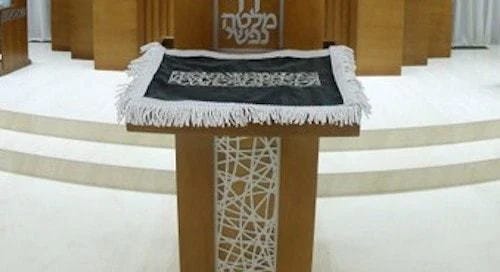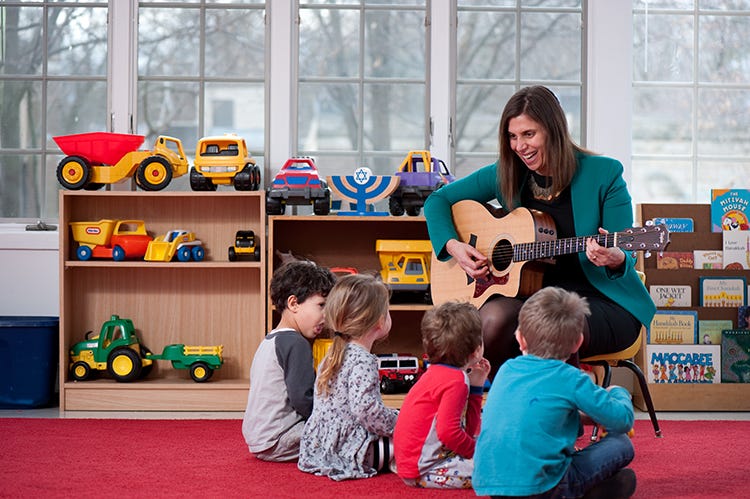An institution which housed one of the few cantorial schools in the world recently reached out to its faculty, alumni, and students, announcing the “pause” in its cantorial program. You’ll probably hear more about it soon.
As a former faculty member, I’ll be frank that the cantorial students, faculty, and alumni of the school do not believe that this is a pause. Rather, it is the culmination of a willful administrative neglect and de-centering of the cantorial school over the past five years which caused both a significant downturn in enrollment and a plummeting of morale amongst students and faculty.
Sadly, I was not surprised when this happened. I’m a veteran of these kinds of things. While I was a student at the Jewish Theological Seminary in 2010, the H.L. Miller Cantorial School suffered a great blow when its respected dean, Cantor Henry Rosenblum, had his position surprisingly eliminated. The cantorial students found out on a Friday morning, conceivably so that we would “cool down” over the weekend. We were in shock, meeting in the second floor lounge just before Shabbat, lamenting what this meant for the future of our school and our value to the administration.
The “cool down” did not come: That following Monday, sixty plus students and faculty (including rabbinical students) joined for a solidarity prayer service followed by a meeting with Chancellor and Provost. In a sweaty, packed classroom, our administrators seemed totally surprised at the shared level of upset and concern. The cantorial school itself suffered horrible press indicating that it was “shuttering” (a synonym for closing, which was not true), and enrollment took a huge hit for many years to come.
Despite this adversity, the students of the H.L. Miller Cantorial School flourished under the keen and adaptive leadership of my colleague, Cantor Nancy Abramson. But the cancel-the-cantors cohort is always lurking in the wings. When JTS was looking for its new Chancellor, word spread that members of the JTS board openly encouraged their candidates to close the school. Thankfully this has not come to pass, at least not yet.
—
The ambivalence of institutions towards the cantorate ironically comes at a time of ascending cantorial leadership in American synagogues. This year’s conventions of the United Synagogue for Conservative Judaism and the Union for Reform Judaism both featured cantors more prominently than ever in music, education, and conference leadership. Their respective cantorial organizations, the Cantors Assembly and American Conference of Cantors, have ascended in public-facing programming and in activity within their movements, particularly since the pandemic.
Cantorial leadership is also growing on the ground. Whereas less than half of today’s liberal rabbinic graduates serve in pulpit positions, cantors are largely tied to the institution of the synagogue. The ranks of cantors serving as “sole clergy” has soared in North America, particularly as seminaries and congregations face a bleak clergy shortage. If I had to advertise for the cantorate today, the slogan I would use is this: We are there for you.
Ambivalence towards cantorial education is usually couched in familiar terms like financial constraints and recruitment challenges. But this is rarely the whole story.
Dozens of endowed fellowships and professional development opportunities have been directed towards improving the ministry and practice of both student and working rabbis and educators. This is fantastic — and yet the cantorate is largely left out of such investment. This is perhaps due to the cantor’s more domestic role in the synagogue: you don’t get a Covenant award for being a bar mitzvah tutor, running a good congregational music program, or leading inspiring worship. But you do change people’s lives. So perhaps it is cantorial participation in the congregational care economy, rather than the realms of entrepreneurship, that makes it (with no small irony) a less glitzy investment. In some ways, it reflects a similar challenge in arts-related funding across the philanthropic world, in which arts-based impacts are more difficult to quantify for funders and grant-making organizations. The power of music—and the relationships it engenders in the context of Jewish identity and commitment—ultimately makes a better story than a spreadsheet.
But the ambivalence of some Jewish institutions goes even further, and is often inherent in the rabbinical administration of cantorial education. As my colleague Cantor Hinda Labovitz writes:
“Cantorial education as part of an academic institution was an American innovation of the mid-20th century; in the history of the cantorate, it is only a recent phenomenon. The first cantorial schools in the United States were founded in the mid-twentieth century in quick succession: the School of Sacred Music at Hebrew Union College in 1947, the Jewish Theological Seminary Cantor’s Institute in 1951, and the Cantorial Training Institute at Yeshiva University in 1954. The Cantor’s Assembly, founded in 1947, dedicated itself to the “conservation and enhancement of the traditional musical heritage of the Jewish people, to establish and maintain the highest standards for the cantorate and to delineate the expanding role of the ḥazzan in the American synagogue.
Why were these schools and organizations started in such close proximity, and why, significantly, in the late 1940’s? The proximity of these dates to the end of the Holocaust is not accidental. The antisemitic world had just destroyed six million Jews and with them an indeterminate number of memories and melodies. Among the Jews murdered were a significant number of musicians, including the ḥazzanim of decimated communities. In the aftermath of the Holocaust, with the influx of European Jews to the United States, and with the vacancy of Jews in Europe, America became the new center of world Jewry.
Because rabbinical schools were already established, it made sense to “hitch the wagon” of cantorial education to these institutions. But doing so created other issues. It brought into focus the differences between rabbinic and cantorial training. In most institutions, cantorial schools – which required accreditation in order to grant advanced degrees alongside ordination – became accountable to and reliant upon the rabbinical training institutions to provide infrastructure.“
The training of rabbis and cantors together is worthy. These two groups (together with the shammash, the medieval antecedent of the executive director) have been long counted as klei kodesh – vessels of holiness. They are both responsible for mitzvot, leadership, and teaching Torah. Yet these two groups are also often populated by different types of people – the scholar and the musician, the ethicist and the aestheticist.

Such human tensions minimally go back three hundred years, when the cantorate declared functional independence in early modern Europe by creating musical structures which a musical layman could no longer execute. This was a major disruption in the Ashkenazic sphere, as rabbis were the preferred shlichei tzibbur in Ashkenaz for its first several centuries – before the introduction of musical complexity. Cantors also spent the last three centuries developing, together with folk practice, specialized ensembles and religious forms of musical depth, yielding a sacred sonic priesthood of grandeur and emotionalism. This legacy, and the millennium of expressive cantor-poets that preceded it, has long put us in tension with Talmudic and early chasidic models of musical equity, where the vocal norm is "al tifrosh min hatzibbur” – do not separate yourself from the community.
Such realities makes it even more challenging to envision how a rabbinical school, modeled on a breakaway sect of Ashkenormative but equity-based charismatic Jewish practice, relates to the cantorate, which is historically the voice of the formalized kehillah, the am, and even (l'gnai) sometimes the voice of the am ha'aretz. These differing intuitions about aesthetics, specialization, society, and even theology should be complementary, in the same way that the prophetic books of Samuel and Kings complement the priestly books of Chronicles. But when they are seen as simply in opposition, the cantorate suffers. The recent closing is an example of this lack of vision.
Ironically, the first term for cantorial ordination was “investiture” — a term borrowed from the priesthood, and perhaps indicating the subtle theological and philosophical differences practiced by the rabbinate and cantorate. This is because the cantorate, in all of its diversity and embrace of contemporary models of musical equity, still champions specialized, dare I say priestly ideals in the realm of music: literacy in notation; the spirituality of musical complexity; hierarchical musical forms; the importance of minhag, nusach, and received traditions; and, in the West, the stakes of Western sound in Jewish musical practice. This differs from the many of the musical impulses within the rabbinate, and the ascendant model of leadership via charisma and equity rather than position or hierarchy, musically or otherwise.
Both of these impulses are profoundly human, and also profoundly Jewish. As Aaron Wildavaky wrote in his book, Moses as a Political Leader, Moses’s great innovation was harnessing both of them while trying to avoid the pitfalls of each.
A cantor-positive cantorial program would celebrate the specialization, vocation, and priestly functions of the cantorate, while also being watchful of its manifest challenges and integrative of current trends. Such a program would include a holistic approach to Minhag Ashkenaz, both from a halachic and cultural perspective, teaching its language, foods, music, dance, and other folkways, as well as a thoughtful, positive-historical orientation towards traditional musical forms (but without exclusive fealty to them). It would also be grounded in personal piety, religious formation, communal service, and mussar.
In search of nourishing religious narrative (aggadah) for a cantorate in partnership with the rabbinate, one might explore some of the following narratives:
Judah and Joseph, whose spirituality and leadership complement each other
Moses and Aaron, the archetype of the brotherhood of prophet and priest
Priests & Prophets and how they worked together in the biblical period
The Book of Chronicles (which I call the cantorial history of biblical Judaism)
The stories of Talmudic rabbis who were also levites and kohanim
Prayer leadership, piyyut composition, and hazzanut in the gaonic period
Early modern Jewish theologies of musical complexity
Cantors in the courts of the hasidim, and cantors who were inspired by their chasidic background (Cf. Zeidele Rovner, Nissi belzer, Yossele Rosenblatt, etc.)
Established institutions like JTS, HUC, Aleph, Academy for Jewish Religion, Academy for Jewish Religion - California, and cantorial startups like EAJL and École Rabbinique de Paris are creating great cantors and we should applaud and support their efforts, especially now. But the words of my colleague, Cantor Labovitz, remain true: “A future for cantorial training that does not rely on a rabbinical training institution for its infrastructure, administration, and supervision is an imperative for the future of the successful cantorate. Now is the time.”
There are many possible solutions. But it is clear that cantors need a new way forward.







I think this is brilliantly insightful as well as very helpfully informative.
From a personal basis, every brachah for more power to Eajl,
Excellent review, Matt. Glad you added below the many additional cantorial education programs existing in the US and abroad.
I am a graduate of the ALEPH cantorial program which is experiencing the challenges you elude to in your introductory paragraphs.
I must say that my education was enhanced by sharing many pathways with rabbinical students, with whom we share the pulpit following smicha.
There is significant overlap in our roles of pastoral care, student education, and clerical leadership in the community. Your comment regarding sole cantorial spiritual leadership of communities is a reason why shared programs are advisable.
The particularism and esoteric aspect of the cantorate can be emphasized, however, there is important cross fertilization that arises by ‘ running together’ during years of intense training, not the least of which is the understanding of the growth experience both groups share.
I do agree that cantors should be intimately involved in shaping the nature of the experience of cantorial education.
Your historical perspective, as always adds to the discussion
Todah Raba, Hazzan